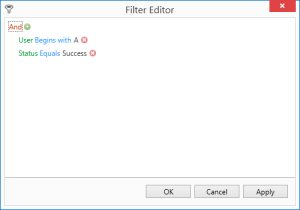Agents Table
Overview
The Agents report contains two separate table views that display information about existing task agents, process agents and agent groups. The parent table displays basic information about an agent or group (for example, name, creation/modification date, etc.). The child table displays detailed information about dependencies of an agent or agent group, such as which tasks are set to run on the agent/group, which events or conditions are set to fire on the agent/group and the workflows that contain these objects. If selecting agent group details, information about all agents contained in the specified group will be included in the child table as well.
To access the child (dependencies) table, select the See details link under the Dependencies column. This displays a table that includes additional details regarding dependencies for the specified agent or group. To return to the parent table, select the Back button located on the top-left corner of the table.
For complete instructions on how to use table reports, see Using Table Reports
Data sources
The Agents report displays data in a two-dimensional table. The bound data is arranged in columns and rows. Grid columns correspond to data fields in a data source, rows represent data records. The report consists of a parent table that details existing agents and agent groups and a child table that describes all dependencies that exist in a particular agent/group. Below describes the available data sources contained in both parent and child tables.
Parent table
The following describes the available data sources contained in the parent table.
| Column | Description |
|---|---|
| ID | A unique identifier assigned for the agent or agent group. |
| Name | The user defined name of the agent or agent group. |
| Type | The type of object (that is, workflow, task, event, or condition). |
| Created By | The name of the user that created the agent/group. This information also appears in the agent's Details property. |
| Created On | The date and time the agent/group was initially created. This information also appears in the agent's Details property. |
| Modified On | The date and time the agent/group was last modified. This information also appears in the agent's Details property. |
| Enabled | Specifies whether the agent is globally enabled or disabled as specified in the Details property (Enabled = True, Disabled = False). |
| Status | The status of the agent or agent group (for example, Connected, Disconnected). |
| Notes | Displays any notes entered about the agent or agent group as specified in the Notes property. |
| Dependencies | Objects that are reliant to the specified agent or group, including tasks set to run on the agent/group, events or conditions set to fire on the agent/group and workflows where such objects reside. |
Child table
The following describes the available data sources contained in the child table.
| Column | Description |
|---|---|
| ID | A unique identifier assigned for the object. |
| Name | The user defined name of the object. This can be the name of a task, workflow, event, or condition. |
| Type | The type of object (that is, workflow, task, event, or condition). |
| Path | The path to the object as shown in the Repository. |
| Created By | The name of the user that created the object. This information also appears in the object's General Properties under the Details property. |
| Created On | The date and time in which the object was initially created. This information also appears in the object's General Properties under the Details property. |
| Modified On | The date and time in which the object was last modified. This information also appears in the object's General Properties under the Details property. |
| Trigger Type | The type of trigger used to start workflow/task execution (if relevant). |
| Enabled | Specifies whether the object is globally enabled or disabled as specified in its General Properties under the Details property (Enabled = True, Disabled = False). |
| Empty | Specifies whether the object contains steps,
properties or other elements required for execution (if the object
contains such items, returns FALSE, if not, returns TRUE). Properties
and elements vary based on the type of object. See below:
|
| Notes | Displays any notes entered about the object as specified in the object's General Properties under the Notes property. |
Filtering
You can filter this report by columns that represent the data source. A filter list is available for column filtering and a Filter Editor is available for comprehensive filtering.
Filter by columns
The Columns ![]() icon allows you to filter the columns to be included in
the report. To filter by columns, select the Columns
button, and then select/deselect the desired columns.
icon allows you to filter the columns to be included in
the report. To filter by columns, select the Columns
button, and then select/deselect the desired columns.
Filter by column data
To filter the data in a column: over your mouse over the column until a filter icon appears, and the Filter button allows you to filter the data that appears for a certain column.
-
Hover your pointer over a column header, and then select the Filter icon that appears.

-
Select the column data to include in the report from the list.
Advanced filtering
The Filter Editor allows you to build complex filter criteria with an unlimited number of filter conditions combined by logical operators. To open the Filter Editor, right-click any column header, and then select Filter Editor. The Filter Editor displays filter criteria as a tree structure, where nodes represent simple filter conditions. If the filter criteria consists of multiple filter conditions, the Filter Editor contains multiple nodes linked by logical operators.
